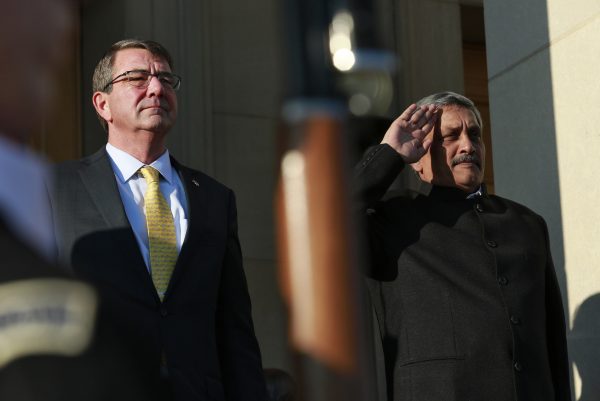LEMOA will overall enhance inter-operability and allow both nations to use each other’s military facilities during peacetime operations as well as in times of crisis. But LEMOA does not augment any commitment from New Delhi to support the United States when it faces a security threat.
Parrikar’s visit to the United States coincided with a reciprocal visit by US Secretary of State John Kerry to Delhi for a ‘two-plus-two’ strategic dialogue. The recent plethora of bilateral cooperation underlines the phenomenal progress that the India–US strategic relationship has made in recent years. In contrast, negotiations over a bilateral customised agreement in 2003 lasted for over a decade.
LEMOA is a unique pact, differing from the text of the Logistic Support Agreement the United States has signed with more than 60 countries. Though various agreements have been finalised for greater technological cooperation between the countries, especially on defence and strategic technologies, India sought a ‘special treatment’ from the United States — something the US Senate could not so easily waive — in order to enhance cooperation.
The significance of these improved ties is that it has taken the United States almost six decades to recognise India’s role in shaping its regional security architecture. LEMOA is a major and decisive step in the direction of making India a ‘linchpin’ of the US rebalance to the Indo-Pacific.
Besides considering India as a major defence partner, the United States is also looking to increase defence trade and technology sharing with India to a level commensurate with its closest allies and partners. In the words of the US Defence Secretary Ashton Carter, this ‘is a very substantial change’.
In contrast, the Indian Ministry of Defence is attempting to de-emphasise these deeper strategic ties, asserting that LEMOA ‘does not create any obligation on either party to carry out any joint activity’ and ‘does not provide for the establishment of any bases or basing arrangements’. The Ministry of Defence also insisted that LEMOA only gives ‘logistics support to each other’s fleet, like supply of fuel, supply of many other things which are required for joint operations, humanitarian assistance and many other relief operations’. Such statements highlight the complexity of this relationship and the inhibitions the Indian side harbour in having to project this partnership without diluting its coveted strategic autonomy.
Putting India’s reservations to one side, the new agreement must be seen in the context of changing Indo-Pacific security dynamics, with China emerging as a major security concern for both India and the United States. While Washington initially sought to make India a closer ally in its Asia strategy, lately it has realised New Delhi’s predicament in joining the US-led system.
For instance, China was deeply opposed to the 2007 Malabar joint naval exercises between India, Japan and the United States and indicated this displeasure to Delhi, arguing that it was not in India’s strategic interest to side with the United States against Beijing. Since then the relationship has progressed bilaterally without any irritants.
With the Pentagon’s recently adopted sequestration policy aimed at reducing US defence expenditure drastically, Washington is hoping for friendly countries to emerge strongly in different regions. This push comes from the US’s desire to avoid getting bogged down in more petty regional security contingencies and instead focus on gaining a competitive strategic edge over China.
LEMOA, for its part, doesn’t generate any obligation on either party to use its facilities. At the same time, a customised pact would help to generate more cooperation between the two especially in the defence technology sector, something India is desperately seeking from the United States. This would be more in line with India’s traditional position on alliances and go towards fulfilling the ‘Nehruvian’ vision of making India a strong, independent and recognised nation in the international system.
Indeed, when the India–US strategic partnership was initiated at the dawn of the century, its chief architect, President George W. Bush, had envisioned the Asia-Pacific region as the emerging arena in US strategic calculus and declared China as a ‘strategic competitor’.
President Obama ensured the continuation of this vision when he visited India in 2015. But things have not turned out exactly as Obama expected. While India is a major alliance in the region, it hasn’t played the major role in the US’s ‘rebalancing’ strategy that Obama envisioned.
For the United States, LEMOA is a major indication of the important role that India plays in its security vision for the Indo-Pacific. For India, LEMOA is a positive step towards seeking more cooperation in defence technology that will propel its own naval power in the Indian Ocean. A militarily strong India can counter China in the region while facilitating American interests.
Joshy M. Paul is an Assistant Professor in International Studies at Christ University, Bangalore.

